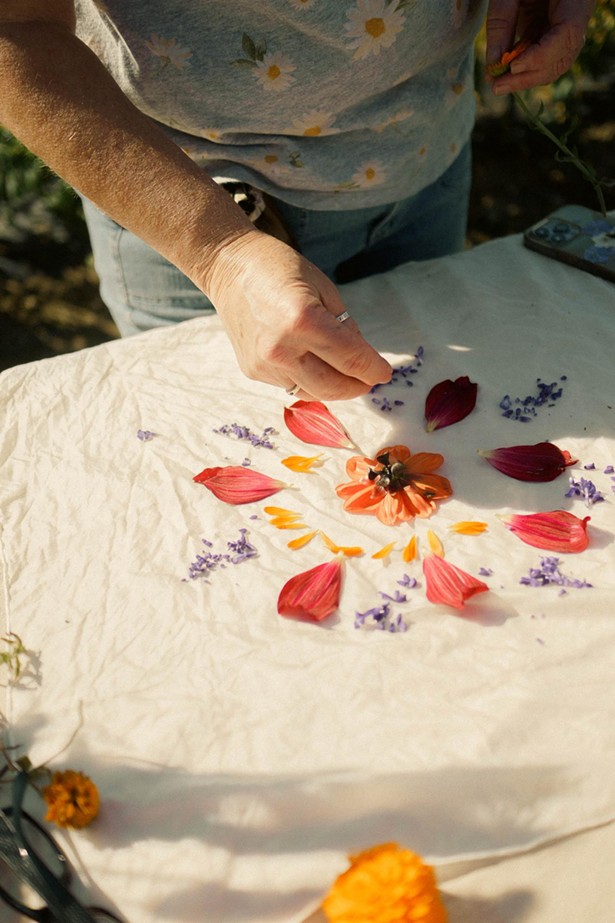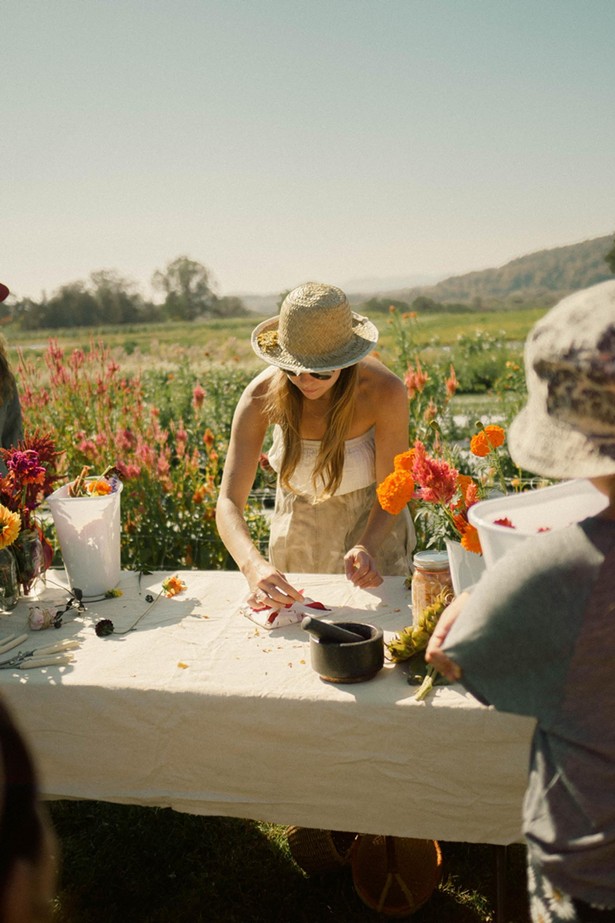In 2017, Hannah Ross was working for the New York City Ballet as the costume dyer and painter when her dye lab got shut down, causing her to lose her job. Inspectors deemed the working conditions unsafe; she had been using highly toxic chemicals derived from crude oil. That rude awakening led Ross to decide to exclusively use all-natural dyes in her work and artistic practice, Hanoux.
Ross created Hanoux as both her brand and artist name shortly after graduating from the Pratt Institute in 2013 with a BFA in fashion design. She worked in fashion houses, costume design, and production before realizing that her values and interests were at odds with the realities of the fashion industry. She had traded in her hands-on seamstress skills for daily stints at a computer, and felt removed from the rest of the design process.
“I am so connected to the materiality and transparency of where those materials come from,” Ross says. “Who’s growing them? What are the hands touching the materials along the way? And then in the end, the story that’s being translated to the consumer of where it came from and how it was made is completely lost in fast fashion brands.” After her NYC Ballet job ended, she spent two years in Oaxaca, Mexico, studying natural dyeing, weaving, and textile production with local artisans, and credits much of her knowledge to their teachings. Today, Hanoux is a Hudson-based textile studio that uses natural dyes created through a process-oriented, hyper-localized, and ethically-sourced approach.
” class=”uk-display-block uk-position-relative uk-visible-toggle”>

In 2020, Ross and her boyfriend purchased a 50-acre plot in Taghkanic, where Ross cultivates fields of plants used for natural dye.
Through Hanoux, Ross produces small-batch orders for clients, teaches natural dyeing workshops, and dyes textiles for select local and regional brands. She sells upcycled vintage clothing at pop-ups like Basilica Farm and Flea, sourcing white garments with small imperfections and revitalizing them with natural dye. Ross also creates medicinally-dyed hemp fiber bodysuits under the moniker Plant Skin, the last of which sold out online this August. The collection explores both spiritual and physical nourishment through plants, in keeping with the definition that Ross assigns to the word Hanoux: “to heal through organic color, shape, pattern and living with earth’s cyclical rhythms.”
In 2020, Ross and her boyfriend purchased a 50-acre plot in Taghkanic, where Ross cultivates fields of plants used for natural dye. The fields consist of indigo (blue), madder root (red), and marigold (yellow), which provide Ross with the primary color palette. To supplement the yield of her slowly burgeoning garden, Ross forages wild plants (sometimes including the ones in neighbors’ yards,) and stores the pickings in her barn for future use. She most often uses Hudson Valley plants considered to be in abundance, like mugwort, Japanese knotweed, or goldenrod; or waste products, like the husks of black walnuts.
” class=”uk-display-block uk-position-relative uk-visible-toggle”>

Ross spent two years in Oaxaca, Mexico, studying natural dyeing, weaving, and textile production with local artisans, and credits much of her knowledge to their teachings.
The projects that excite Ross most are ones with clients who share her commitment to natural sourcing and ethical production. She created a meditation cushion with LikeMindedObjects in Hudson, a furniture studio that partnered with the Columbia County dump to shred old clothing to make the cushion filling. “That’s my angle when I’m designing products that are coming out of Hanoux: what’s around me right now?” Ross says. “How can I uplift and highlight what other designers are doing that I agree with? How can we come together and not rewrite the wheel every time, utilize the skills and designs that people are already working with.”
Ross was an adjunct professor at Rutgers University for two years, teaching fabric dyeing for costume design until the pandemic. She also holds introductory bundle dye workshops, and brought them from Brooklyn to the Hudson Valley in 2020. In an effort to offer a deeper curriculum, she now hosts six-hour “community dye baths,” where students bring a garment from their wardrobe and dye it the color of the month, which is chosen by Ross according to the seasonality of local plants. Ross typically runs at least one workshop a month. “My ethos as a teacher is to get people as connected as possible to the materials that they’re using and the materials that are around them,” she says.
” class=”uk-display-block uk-position-relative uk-visible-toggle”>

Ross hosts six-hour “community dye baths,” where students bring a garment from their wardrobe and dye it the color of the month, which is chosen by Ross according to the seasonality of local plants.
Living in the Hudson Valley has increased Ross’s focus on the hyperlocal. She cites a network of people creating products from start to finish in New York State, including plant dye farmers, sheep herders, and small fabric and textile producers. “It feels like we’re pulling this golden thread and unraveling how local we can be as consumers and producers,” Ross says.
In 2024, Ross will launch a new studio, Conscious Color, a separate endeavor from Hanoux and her own artistic practice. She and her father are currently renovating the barn to be a state-of-the-art textiles studio, and she hopes that it will eventually be host to longer-form classes and artist residencies. Breaking with her previous work, Conscious Color will exclusively use the color palette grown on Ross’s land for its educational workshops and custom natural dyeing services.
“It’s a skill that I want everyone to have in their pocket to break down consumerism, to change everyone slowly from a consumer to a creator. That’s really the overarching inspiration for teaching,” Ross explains. “Little by little, if everyone changes consumer habits to creator habits, we’ll be a lot better off.”